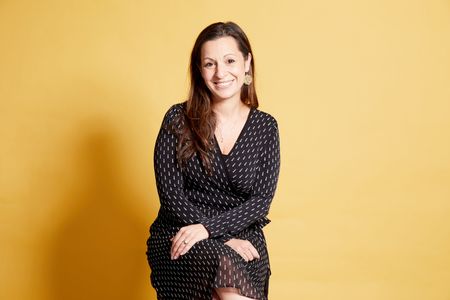Help for Anxious Times

Photos By Kelly Davidson
Help for Anxious Times
Faculty offer advice for supporting children’s mental health in a year marked by a pandemic and continued police brutality
The last time Massachusetts asked its residents to go into lockdown was in the aftermath of the 2013 Boston Marathon bombing. As police closed in on the suspects, residents were told to shelter in place. Confined indoors, Jennifer Greif Green and her husband, then a high school teacher, talked about how he should discuss the events—a bomb that killed a child, a suburban gunfight, a tense manhunt, frightened families hiding at home—with his students.
“He’s used to being able to prepare for class in advance and has enough experience to have a pretty good idea for how conversations will progress,” says Green, an associate professor of special education and a child clinical psychologist. “But with something like this, it felt much more uncertain.”
Green’s husband became a frontline mental health resource for his students. Unlike most of his colleagues, he at least had an expert to go to for advice. Later, Green turned the postmarathon experiences of teachers like her partner into a research project. She found they were attuned to their students’ psychological distress, but that many schools lacked plans to help them do anything about it.
After a turbulent—often heartbreaking—2020, dominated by lockdowns and punctuated by acts of police brutality and racism, children of all ages are experiencing unprecedented levels of trauma and anxiety. In May, an American Civil Liberties Union of Southern California survey found more than half of students may now need mental health support.
But as educators grapple with the ongoing crises, many still don’t have the resources—or training—they need to identify and help students in need. The National Association of School Psychologists recommends one psychologist per 500 to 700 students; the national ratio is closer to one per 1,400 and, in some states, one per 5,000. And that was before school budgets—and staff positions—were cut because of the COVID-19 recession.
“Everyone I’ve talked to in schools feels like the needs of their students outweigh the support they have,” says Green.
She and her colleague Amie Grills, a clinical psychologist and member of BU’s mental health task force, are working on new projects and resources to support teachers dealing with the impacts of a trying year—and to help bring about systemic change.
“There are no ifs, ands, or buts about it. Reaching more kids is highly necessary, and schools are a really good way to do that,” says Grills, a professor of counseling psychology and applied human development who’s also examined how trauma after events like residential fires, extreme violence, hurricanes, mass shootings, and sexual assaults shapes children’s well-being. “It’s important to break down those barriers to care, to say mental health services are an important part of a bigger public health need; we need to develop strategies to support schools to be part of that.”
Help for Today
The trouble for many teachers—even during a normal year, with regular, in-person classes five days a week—is that anxiety is especially hard to spot.
“It’s often misunderstood, or people mislabel what’s going on with kids who are anxious,” says Grills. “The anxiety is causing them such internal distress, but it’s hard to see that.”
Despite its hidden nature, anxiety can often explain sagging classroom performance, faulty emotional regulation, or inattentiveness. Green advises teachers who see unusual behavior to consider mental health issues as a possible cause. At the height of the first rush of COVID-19 lockdowns, she developed an online stress education program to help teachers already dealing with a spike in student anxiety. Created in partnership with the Medway, Mass., Public Schools, which also provided funding, it walks teens through the basics of stress and its symptoms, finishing with a series of coping strategies and other well-being tips. (The free course is available at jenniferggreen.com/stress.)
“If there’s a student with their head down on a desk, there are a number of different ways that a teacher might interpret that behavior,” says Green. “It might be that they’re tired, but it might also be a sign of depression or anxiety.”
Green says the National Association of School Psychologists (nasponline.org) has lots of mental health resources—for parents, too—including advice for talking about COVID-19, trauma, and loss. Grills recommends anxietycanada.com and the Association for Behavioral and Cognitive Therapies website (abct.org), which both have free resources and programs.
In her research, Grills has built mental health support programs that can be incorporated into normal classroom activities. One is a 10-minute cognitive behavioral intervention for anxiety designed to be delivered daily in a school setting by a teacher. Along with colleagues at the University of Texas at Austin, she’s testing its efficacy among children who might be falling behind their peers in reading.
“If your child is struggling in school and they’re having difficulty learning to read, does that make them anxious or is it the kids who are really anxious who are preoccupied by that and can’t focus?” says Grills. “We found it’s actually both—a chicken or the egg situation.”
Her program integrates “evidence-based cognitive behavioral therapy skills and self-efficacy building strategies” into small group reading lessons.
“One of the critical aspects of this program is that it is brief and integrated in this way,” she says. “If a kid is struggling with learning, the last thing a school wants to do is pull them out of instruction time.”
Help for Tomorrow
Unlike many past traumatic events—a hurricane that tears through a town, a bombing in a city—COVID-19 didn’t spare any states. The need for more student mental health support is universal.
Because of the scope of the problem, many changes have to come at the state level, says Green. She recommends states update their licensure requirements to include mental health education for all new teachers. At the moment, although BU Wheelock offers classes on emotional and behavioral disorders, there’s no obligation in Massachusetts or most other states for preservice teachers to understand the basics of supporting students with mental health issues.
“The state licensure issue is one we need a lot of advocacy around,” says Green. “Studies show up to 40 percent of adolescents will have a mental health problem at some point, yet our teachers who are spending the most time with students are not being prepared to support them.”
With Melissa K. Holt and Kathleen Corriveau, both BU Wheelock associate professors, Green recently began an evaluation of online avatar programs that aim to give preservice teachers more experience spotting mental health issues. The programs, from health simulation company Kognito, replicate conversations with students and coach participants on specific strategies.
“We’ve been looking to see if it could help teachers before they even start teaching to feel more confident and prepared to address the mental health needs of their students,” says Green, whose study is funded by the Spencer Foundation. BU already offers a higher education–tailored Kognito program to its faculty and staff.
Grills wants states to hire mental health experts, too—people schools and districts can turn to for advice about problems and potential solutions. “Districts don’t know which programs are good versus those that are not,” she says. She gives the example of off-the-shelf mental health curricula. Sold by companies through slick websites and glossy brochures, they can seem like a compelling, prepackaged solution. But Grills says many aren’t supported by evidence; in fact, she says, some may do more harm than good.
“What we see is schools and teachers struggling and not having a deep bench background in mental health,” she says.
Racial discrimination is also a factor in the provision of care. In April 2020, Green and Elizabeth Bettini, a BU Wheelock assistant professor of special education, were coauthors on a study that found Black and Latinx students were much more likely than their white peers to be removed from their classes—even their schools—and placed in settings serving students with emotional and behavioral disorders. Green has also started a new project, funded by BU’s Center for Innovation in Social Work & Health, to examine the role of police in responding to mental health crises, such as when a child’s behavior escalates or if they fight with a teacher.
“If the school had sufficient mental health providers on-site, that would be a time to get a school psychologist or counselor involved who might be able to help with de-escalation or change the direction of the situation,” says Green. “When schools have limited resources, they will often call on the police.”
Both Green and Grills hope the crises of 2020 help raise the importance of evidence-based mental health provision in schools.
“It’s making me want to redouble my efforts to support student mental health and well-being,” says Green, “and focus on social and emotional development and how to move that from the sidelines of schools into their central mission and permanent structure.”

